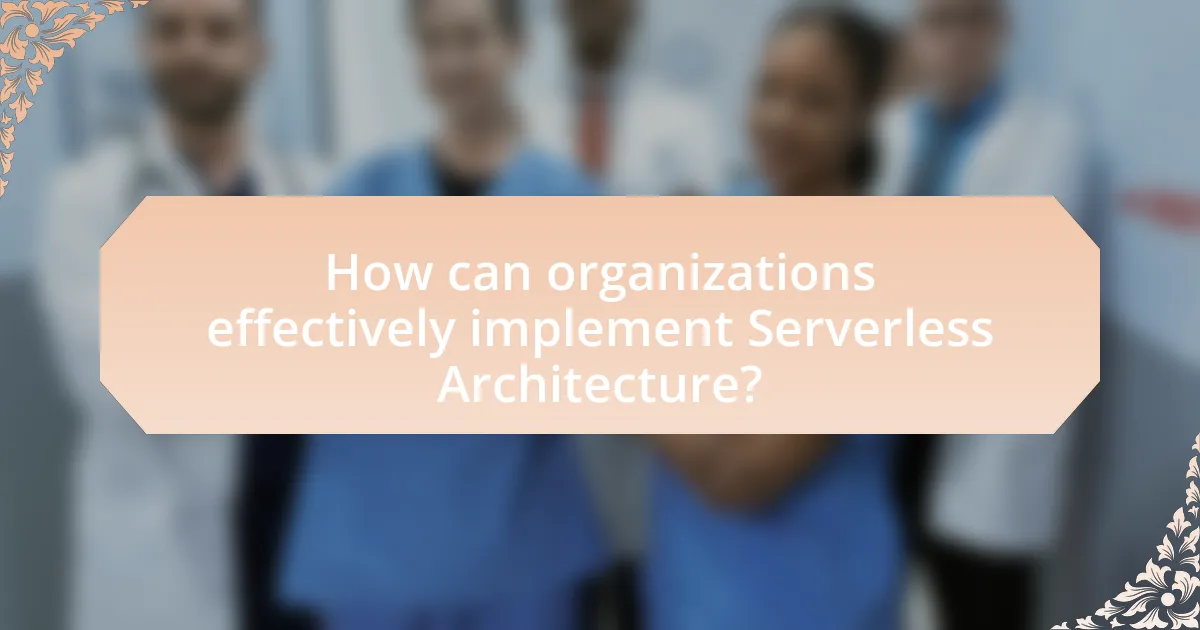Serverless architecture is a cloud computing model that enables developers to build and run applications without the need for server management, allowing for enhanced scalability and reduced operational costs. This article explores the differences between serverless and traditional architectures, highlighting key components such as Function as a Service (FaaS) and Backend as a Service (BaaS). It discusses the benefits of automatic scaling, reduced latency, and pay-per-use pricing, which collectively optimize performance and resource management. Additionally, the article addresses implementation strategies, common challenges, and security considerations, providing practical tips for maximizing the advantages of serverless architecture in performance optimization.

What is Serverless Architecture?
Serverless architecture is a cloud computing model that allows developers to build and run applications without managing server infrastructure. In this model, the cloud provider dynamically allocates resources and manages server operations, enabling developers to focus solely on writing code. This approach enhances scalability and reduces operational costs, as users only pay for the compute resources consumed during execution. According to a report by Gartner, serverless computing can lead to a 30% reduction in operational costs for businesses, demonstrating its efficiency and effectiveness in optimizing performance.
How does Serverless Architecture differ from traditional architectures?
Serverless architecture differs from traditional architectures primarily in its operational model, where server management is abstracted away from developers. In traditional architectures, developers are responsible for provisioning, scaling, and maintaining servers, which can lead to increased operational overhead and complexity. In contrast, serverless architecture automatically scales resources based on demand, allowing developers to focus solely on writing code without worrying about infrastructure management. This model enhances efficiency and reduces costs, as users only pay for the compute time consumed, rather than for pre-allocated server capacity. According to a report by AWS, serverless computing can reduce operational costs by up to 70% compared to traditional server-based models, demonstrating its effectiveness in optimizing performance and resource utilization.
What are the key components of Serverless Architecture?
The key components of Serverless Architecture include Function as a Service (FaaS), Backend as a Service (BaaS), event-driven computing, and API gateways. FaaS allows developers to run code in response to events without managing servers, while BaaS provides ready-to-use backend services like databases and authentication. Event-driven computing enables automatic scaling and execution of functions based on triggers, and API gateways facilitate communication between client applications and serverless functions. These components collectively enhance performance optimization by reducing operational overhead and enabling rapid deployment.
How does the event-driven model work in Serverless Architecture?
The event-driven model in Serverless Architecture operates by triggering functions in response to specific events, such as HTTP requests, database changes, or file uploads. In this model, developers write small, stateless functions that are executed only when an event occurs, allowing for efficient resource utilization and scalability. For instance, AWS Lambda, a popular serverless platform, automatically scales the execution of functions based on the number of incoming events, ensuring that resources are allocated dynamically and only when needed. This approach minimizes idle resource costs and optimizes performance, as functions can be executed in parallel, responding to multiple events simultaneously.
What are the core principles of Serverless Architecture?
The core principles of Serverless Architecture include event-driven execution, automatic scaling, and pay-per-use pricing. Event-driven execution allows functions to run in response to specific triggers, such as HTTP requests or database changes, enabling efficient resource utilization. Automatic scaling ensures that the infrastructure can handle varying loads without manual intervention, allowing applications to scale up or down based on demand. Pay-per-use pricing means that users only pay for the compute resources consumed during function execution, which optimizes costs and encourages efficient coding practices. These principles collectively enhance performance optimization by reducing overhead and improving responsiveness in application deployment.
Why is scalability important in Serverless Architecture?
Scalability is crucial in Serverless Architecture because it allows applications to automatically adjust resources based on demand, ensuring optimal performance and cost efficiency. This dynamic resource allocation means that during peak usage, the system can handle increased loads without manual intervention, while during low usage, it can scale down to minimize costs. For instance, AWS Lambda can automatically scale to accommodate thousands of concurrent requests, demonstrating how serverless solutions can efficiently manage varying workloads. This inherent scalability is a key advantage, as it enables businesses to respond quickly to changing user needs and market conditions without the overhead of managing infrastructure.
How does Serverless Architecture enhance resource management?
Serverless architecture enhances resource management by automatically scaling resources based on demand, which eliminates the need for manual provisioning and reduces idle resource costs. This architecture allows developers to focus on writing code rather than managing infrastructure, as cloud providers dynamically allocate resources only when functions are executed. For instance, AWS Lambda can scale from zero to thousands of concurrent executions, ensuring that resources are utilized efficiently during peak loads while minimizing costs during low usage periods. This on-demand resource allocation leads to optimized performance and cost savings, as organizations only pay for the compute time they actually use.

What are the benefits of Serverless Architecture for performance optimization?
Serverless architecture enhances performance optimization by enabling automatic scaling, reducing latency, and improving resource utilization. Automatic scaling allows applications to handle varying loads efficiently, as serverless platforms dynamically allocate resources based on demand. This leads to reduced latency since functions can be executed closer to the user, minimizing response times. Additionally, serverless architecture optimizes resource utilization by charging only for the compute time consumed, which eliminates the need for over-provisioning and ensures that resources are used effectively. These benefits collectively contribute to improved application performance and cost efficiency.
How does Serverless Architecture improve application performance?
Serverless architecture improves application performance by enabling automatic scaling and reducing latency. This architecture allows applications to automatically adjust resources based on demand, ensuring that they can handle varying workloads efficiently without manual intervention. For instance, AWS Lambda can scale to thousands of concurrent executions, which minimizes response times during peak usage. Additionally, serverless functions are executed in stateless environments, which reduces the overhead associated with server management and allows for faster deployment of updates. This efficiency is supported by studies showing that serverless applications can achieve up to 90% faster time-to-market compared to traditional architectures, as they eliminate the need for provisioning and managing servers.
What role does automatic scaling play in performance optimization?
Automatic scaling is crucial for performance optimization as it dynamically adjusts resources based on demand, ensuring efficient resource utilization. This capability allows applications to handle varying workloads without manual intervention, which minimizes latency during peak usage and reduces costs during low demand periods. For instance, cloud platforms like AWS Lambda automatically scale functions in response to incoming requests, enabling seamless performance even under fluctuating loads. This adaptability not only enhances user experience by maintaining responsiveness but also optimizes operational efficiency by aligning resource allocation with actual usage patterns.
How does reduced latency contribute to better performance?
Reduced latency significantly enhances performance by minimizing the time it takes for data to travel between the user and the server. This reduction allows for quicker response times, which is crucial in applications where speed is essential, such as real-time data processing and interactive user experiences. For instance, studies have shown that a 100-millisecond increase in latency can lead to a 7% reduction in conversions for e-commerce websites. Therefore, lower latency directly correlates with improved user satisfaction and engagement, ultimately driving better overall performance in serverless architectures.
What cost benefits does Serverless Architecture provide?
Serverless architecture provides significant cost benefits by eliminating the need for provisioning and managing servers, allowing organizations to pay only for the compute resources they actually use. This model reduces operational costs, as businesses avoid expenses related to idle server time and maintenance. According to a study by AWS, companies can save up to 70% on infrastructure costs by adopting serverless solutions, as they scale automatically based on demand and only charge for the execution time of functions. This pay-as-you-go pricing model directly correlates with usage, making it a financially efficient option for varying workloads.
How does pay-as-you-go pricing affect overall costs?
Pay-as-you-go pricing reduces overall costs by allowing users to pay only for the resources they consume, eliminating the need for upfront investments in infrastructure. This model enables businesses to scale their usage based on demand, which can lead to significant savings, especially for variable workloads. For instance, a study by Gartner indicates that organizations adopting pay-as-you-go models can save up to 30% on operational costs compared to traditional fixed pricing models. This flexibility not only optimizes resource allocation but also minimizes waste, as companies are not paying for unused capacity.
What are the implications of reduced infrastructure management costs?
Reduced infrastructure management costs lead to increased operational efficiency and resource allocation flexibility. By minimizing expenses associated with maintaining physical servers and related infrastructure, organizations can redirect funds towards innovation and development initiatives. For instance, a study by Gartner indicates that companies adopting serverless architecture can reduce infrastructure costs by up to 30%, allowing them to invest more in application development and customer experience enhancements. This shift not only improves financial performance but also accelerates time-to-market for new features and services, ultimately enhancing competitive advantage.

How can organizations effectively implement Serverless Architecture?
Organizations can effectively implement Serverless Architecture by adopting a strategic approach that includes identifying suitable workloads, selecting the right cloud provider, and leveraging automation tools. First, organizations should analyze their applications to determine which components can benefit from serverless deployment, focusing on event-driven functions that can scale automatically. Next, choosing a cloud provider like AWS Lambda, Azure Functions, or Google Cloud Functions is crucial, as these platforms offer robust support for serverless applications and integrate well with existing services. Additionally, utilizing automation tools for deployment, monitoring, and scaling can enhance operational efficiency and reduce manual intervention. According to a report by Gartner, organizations that adopt serverless computing can achieve up to 30% cost savings and improved performance due to the automatic scaling capabilities inherent in serverless architectures.
What best practices should be followed for successful implementation?
Successful implementation of serverless architecture requires following best practices such as defining clear objectives, ensuring proper monitoring and logging, and optimizing resource allocation. Clear objectives guide the development process, allowing teams to focus on specific performance metrics and user needs. Proper monitoring and logging are essential for identifying issues in real-time, as studies show that 70% of serverless applications benefit from enhanced observability, leading to quicker troubleshooting. Optimizing resource allocation helps in managing costs effectively, as serverless platforms charge based on usage, making it crucial to configure functions to minimize idle time and maximize efficiency.
How can teams ensure proper monitoring and logging in Serverless environments?
Teams can ensure proper monitoring and logging in Serverless environments by implementing automated monitoring tools and centralized logging solutions. Automated monitoring tools, such as AWS CloudWatch or Azure Monitor, provide real-time insights into function performance, error rates, and execution times, enabling teams to quickly identify and address issues. Centralized logging solutions, like ELK Stack or Splunk, aggregate logs from various serverless functions, allowing for comprehensive analysis and troubleshooting. According to a 2021 report by the Cloud Native Computing Foundation, organizations that utilize automated monitoring and centralized logging experience a 30% reduction in incident response times, demonstrating the effectiveness of these strategies in enhancing observability in serverless architectures.
What strategies can be used to manage vendor lock-in risks?
To manage vendor lock-in risks, organizations can adopt strategies such as multi-cloud deployment, open standards, and regular data portability assessments. Multi-cloud deployment allows businesses to distribute workloads across different cloud providers, reducing dependency on a single vendor. Utilizing open standards ensures that applications and data can be easily transferred between platforms, enhancing flexibility. Regular data portability assessments help organizations evaluate their ability to move data and applications, ensuring they are not overly reliant on one vendor’s ecosystem. These strategies collectively mitigate the risks associated with vendor lock-in by promoting flexibility and adaptability in cloud services.
What common challenges might organizations face with Serverless Architecture?
Organizations commonly face challenges with Serverless Architecture, including vendor lock-in, cold start latency, and debugging difficulties. Vendor lock-in occurs when organizations become dependent on a specific cloud provider’s services, making it hard to switch providers without significant effort and cost. Cold start latency refers to the delay experienced when a serverless function is invoked after being idle, which can impact performance and user experience. Debugging difficulties arise due to the distributed nature of serverless applications, complicating the tracking of errors and performance issues across multiple functions and services. These challenges can hinder the overall effectiveness and efficiency of serverless implementations.
How can security concerns be addressed in Serverless applications?
Security concerns in serverless applications can be addressed by implementing robust access controls, monitoring, and encryption. Access controls ensure that only authorized users and services can interact with serverless functions, reducing the risk of unauthorized access. Monitoring tools can track function performance and detect anomalies, which helps identify potential security threats in real-time. Additionally, encrypting data both in transit and at rest protects sensitive information from interception and unauthorized access. According to a report by the Cloud Security Alliance, 94% of organizations using serverless architectures have adopted security best practices, highlighting the importance of these measures in mitigating risks.
What are the performance implications of cold starts in Serverless functions?
Cold starts in serverless functions lead to increased latency and reduced performance during the initial invocation of a function after a period of inactivity. This latency occurs because the cloud provider must allocate resources and initialize the execution environment, which can take several seconds, significantly impacting user experience and application responsiveness. Research indicates that cold starts can add latency ranging from 100 milliseconds to several seconds, depending on the cloud provider and the function’s complexity. For instance, AWS Lambda cold starts can take up to 5 seconds for Java functions, while lighter runtimes like Node.js may experience shorter delays. This performance implication necessitates careful design considerations, such as optimizing function size and using provisioned concurrency to mitigate the impact of cold starts on application performance.
What practical tips can enhance the use of Serverless Architecture for performance optimization?
To enhance the use of Serverless Architecture for performance optimization, implement the following practical tips: optimize cold start times by minimizing the size of deployment packages, as smaller packages load faster; utilize provisioned concurrency to keep functions warm and reduce latency; and leverage asynchronous processing to decouple services, allowing for better resource utilization. These strategies are supported by findings from AWS, which indicate that reducing package size can lead to a 30% decrease in cold start latency, while provisioned concurrency can maintain performance during traffic spikes.